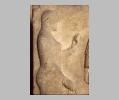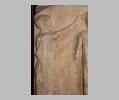| Collection: | Paris, Musée du Louvre |
| Title: | Relief Plaques from Thasos |
| Context: | From Thasos |
| Findspot: | Excavated at Thasos |
| Summary: | Apollo and Nymphs; Hermes and the Graces |
| Material: | Marble |
| Sculpture Type: | Architectural |
| Category: | Separated fragments |
| Placement: | Central position on east and west walls of the passage |
| Style: | Early Classical |
| Technique: | Low relief |
| Original or Copy: | Original |
| Date: | ca. 480 BC - ca. 465 BC |
| Dimensions: | Large relief: H. 0.92 m, L. 2.09 m, D. 0.44 m; Relief with Graces: H. 0.92 m, L. 0.92 m, D. 0.33 m; Relief with Hermes: H. 0.915, L. 0.83 m, D. 0.33 m |
| Scale: | Under life-size |
| Region: | Macedonia |
| Period: | Early Classical |
Subject Description:
The reliefs occupied a central position in the Passage des Theories, an important and expensively constructed structure (walls of marble orthostates) at the northeast corner of the Agora. It takes its name from the list of Theoroi inscribed on the wall, but in addition to its function as a passageway it was apparently an important place of cult.
The large relief was set into the west wall. To the left of a large niche is Apollo in long chiton and mantle, holding a lyre in his left hand. He is crowned by a follower, possibly Artemis. On the right side are three females, identified as Nymphs by the inscription over the niche, variously dressed and carrying offerings. All figures approach the niche, although Apollo has halted and partially turned, presumably to permit his crowning. A clue to the cultic function of the niche is provided by another relief from the acropolis of Thasos, illustrated by Boardman and now in the Getty Museum. Inside the shrine is a statue of a female deity; if seated she is perhaps Cybele although her identification is by no means clear. Although the relief is only partially preserved, the architectural form of the niche is similar and it too is approached by female figures in profile and closely approximate in scale. An archaic votive relief with veiled female figures in a niche inscribed to the nymphs has recently been found in Miletus (Von Graeve in
The east side of the Passage was treated somewhat differently, with an opening for an altar in the center of the wall. The original position of the two small reliefs is not precisely known (the exact location from which Miller removed them was not clearly recorded), but Roux has reconstructed a probable placement on the two facing walls of the niche of the actual altar. Essentially they depict a mirror composition of the two ends of the large relief. On the right side of the altar is Hermes, identified by his characteristic chlamys, cap and kerykeion, and behind him a female in pointed hat, perhaps Hekate. Hermes approaches and extends his right arm toward the actual place of sacrifice in this case, rather than an image of such. On the other relief (essentially, the left half of a single composition) the three females represent the Graces, again identified by the inscription which refers to them in the context of instructions for the cult. They approach the altar from the left.
Note that in some old publications the reliefs are referred to as the Prytaneion Reliefs, from a mistaken identification of their findspot as the Prytaneion of Thasos.
Date Description: The style of the sculpture has usually been thought earlier than that of the inscriptions (inscriptions: second quarter of the 5th century by style, but they have no absolute fixed date). However, if the sculpture exhibits a lingering rather than true archaic style, as had been thought, it is difficult to know how late in the 5th century it was carved. Daux suggested a range of 485-470 BC. Jeffery preferred a date around 465 BC for the inscriptions. Perhaps under the influence of a late dating of the inscriptions, scholars had leaned toward the low end of this range. Most recently, however, Holtzmann has argued for a date just before 480 BC, in which case the style is less out of line with sculpture elsewhere in Greece than had previously been thought. Daux pointed out that the inscriptions may have been added at a later time, despite the close relationship to the reliefs.
Condition: Complete
Condition Description: Large relief from west wall, essentially complete; two smaller reliefs from east wall, also essentially complete. Some fragments of the surface of the reliefs have broken away. The surface is heavily weathered.
Technique Description: Details added in metal (fibula of Apollo, plectrum and strings of the lyre, hair ornaments, etc.).
Inscription:
A: On the molding immediately above the niche of the large relief, in three lines:
Inscription Bibliography:
Associated Building: Thasos, Passage des Theories
Collection History: Discovered by Emmanuel Miller during his expedition of 1864 and brought back by him to Paris. Entered the collection of the Louvre the following year.
Sources Used:
Other Bibliography:





